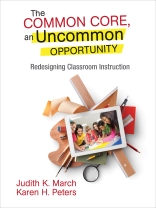Because the Common Core requires bold action
Why The Common Core, an Uncommon Opportunity? Why now? Because it tackles a largely overlooked component of successful implementation: how to redesign your instructional delivery system, K-12. And you’ll have to; if you don’t, you’ll be subject to the very same failure and frustration so many other districts and schools are experiencing. What’s more, March and Peters describe how to integrate 21st Century Skills at the very same time.
What are the big benefits of this book? If you’re a district leader, it will help you
- Develop consistent and structured teaching and learning practices across content areas
- Ensure sustainable processes through continuous curriculum review and revision
- Strategically use data to monitor student performance goals
- Support and sustain enacted reforms through district-wide infrastructure adjustments
- Provide teachers with Common Core-aligned course tools, including sample curriculum maps, lessons, and specific teaching suggestions
‘[This] system helped us not only re-invent ourselves, but also build the internal capacity we needed to maintain our momentum. This book is a must for any district that is serious about taking advantage of the Common Core to re-invent itself.’
—Connie Hathorn, Ph.D., Superintendent
Youngstown City School District
‘Few books offer such deep and specific information to assist the field in successful implementation of the Common Core and state learning standards. . . . This book is a gift to practitioners of all levels, and those practicing in any type of school or district.’
—Dr. Lynn Macan
Cobleskill-Richmondville CSD
قائمة المحتويات
1. No Longer Business as Usual
Major Differences Between the Former Standards and the New Core
Implications for Classroom Instruction and Assessment
The Impact of the 21st Century Skills
International Benchmarking for Global Competition
Implications for Leadership
References
2. Developing Course Tools to Build the Instructional Program
Make the Commitment and Then Get a Game Plan
Unpacking, Bundling, and Sequencing the Standards
Devising Curriculum Maps (or Pacing Guides)
Unit Planning
References
3. Integrating Best Practices to Help Students Construct Meaning
Multiple Levels of Thinking
Goal Setting
Organizational Patterns
Questioning and Cueing
Similarities and Differences
4. Integrating Best Practices Into Unit Plans
Mathematical Problem Analysis and Problem Solving
Vocabulary Knowledge
Delivery Strategies
Recognition and Reinforcement
Continuous Monitoring and Feedback
Basic Assumptions
Chapter References
5. Continuous Assessment to Monitor Results
The Use of High-Stakes Test Results as Entry-Level Data
District Benchmark Assessments
Formative and Summative Classroom Assessments
Common Missteps in Assessment
Strategies for Making Better Use of Assessment Results
Design of Assessments: Traditional Tests and Authentic Assessments
Chapter References
6. Homework and Grading: Two Critical Issues
Homework
Grading Relative to Mastery
Chapter References
7. Implementation and Accountability
Grade-Level or Course Teams
Direct Assistance to Staff
The Observation and Analysis of Classroom Instruction by the Principal
Chapter References
8. Summary and Sustainability
Process Checklist for Chapter 1: No Longer Business as Usual
Process Checklist for Chapter 2: Developing Course Tools to Build the Instructional Program
Process Checklist for Chapter 3: Integrating Best Practices to Help Students Construct Meaning
Process Checklist for Chapter 4: Integrating Best Practices Into Unit Plans
Process Checklist for Chapter 5: Continuous Assessment to Monitor Results
Process Checklist for Chapter 6: Homework and Grading: Two Critical Issues to Success
Process Checklist for Chapter 7: Implementation and Accountability
Appendices
Appendix A: Goal Setting Examples
Appendix B: Questioning
Appendix C: Categorization
Appendix D: Critical Attribution for Similarities/Differences
Appendix E: Teaching the Metaphor for Similarities/Differences
Appendix F: Math Problem Solving
Appendix G: Vocabulary
Appendix H: Collaborative Observation Samples With Action
Plans for ‘Stars’
References












